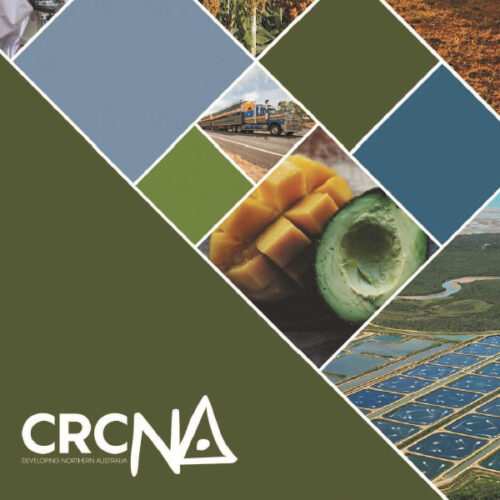
- Author Hartley,N., Shotton,P., Yeates, S., Rhebergen, T., Chauhan,Y., Huth, N., Stanford, J., Lamprecht, M., Eastick, R., Frahm, S., Pembleton, K., Radanielson, Anderson,R., Crawford,C., Cameron,S.
- Publish date June 21, 2023
- Type Report
- ISBN 978-922347-50-1
- Documents
- Broadacre Cropping
Summary
This is the final report for the Potential for broadacre cropping in the NT project which sought to identify potential crops, the timing and length of the potential cropping windows, and the impacts of climate and edaphic conditions on yield and quality.
This report provides an overview of the research undertaken and outcomes of field trials across the Northern Territory. Data gather from these trials were used to determine the productivity of broadacre cropping systems by applying Agricultural Production Systems sIMulator (APSIM) – to investigate how a range of crop species will perform in terms of production and risk profile across the trial sites. Validation trials were conducted under rainfed and irrigated planting systems.
Validation trials included an intensive in-crop sampling and monitoring protocol to match simulated output to actual plant growth dynamics, including soil sampling to at least 1.5 m with full soil water characteristics being determined. Above ground plant data collected in-crop included crop management records, full phenological monitoring, and at determined intervals leaf area, biomass, plant population and light interception, and crop yields.
A key recommendation from this project was the need for the CRCNA to fund a follow up project with the local dryland cotton and broadacre grains growers to address ongoing and emerging needs of the NT cotton industry. In 2023, the CRCNA funded an additional project (Addressing the fundamentals of cropping-systems that deliver sustainable growth of agriculture sector in the Northern Territory) to align with this and subsequent recommendations, which include:
- Investigate solutions to unreliable cotton establishment via a structured and integrated research, development and engagement program developed in consultation with growers, providing more than solutions to the known causes in other crops (high soil temperatures, rapid soil drying and surface crusting) usually due to insufficient soil cover.
- Understand the impact of various crop rotation combinations on productivity of cotton via evaluation of options with growers. This may include pre and post crop management, on-ground plant cover and species impact.
- Optimise nutrition in terms of quantity and time of application of major and minor elements and exploring alternative nutrient options.
- Investigate biosecurity risks associated with cotton and grain rotation system. This can be achieved by monitoring and managing the biological threats by ensuring locally adapted integrated pest management techniques are available and adopted.
- Map and characterise the soil water availability for developing the enhanced cotton growth model. The enhanced cotton growth model can be applied on the most ‘suitable’ soils to assess regional yield and input variability, and identify better regions / locations for sustainable cotton production in the region.
- Determine social acceptance and soil and landscape suitability for the NT Aboriginal titled land.
- Assess application of an economic decision support tool to aid growers’ decision making regarding the type of crops that are viable to develop economically efficient and ecologically sustainable farming systems.
- Review the alignment of a range of potential cropping systems within the Territory’s environment and regulatory frameworks.
Projects
Potential for broadacre cropping in the NT
This project includes co-investment from the Grains Research and Development Corporation (GRDC) and the Cotton Research and Development Corporation (CRDC) with funding reported here as combined CRCNA funding. It will collate historical broadacre cropping data, natural resource information and an understanding of market opportunities to support the development of viable broadacre cropping systems in the NT. This will be achieved by project participants who each bring unique expertise to develop crop management strategies which will help to de-risk broadacre agriculture in the Top End. The initial focus of this project will be on dryland and irrigated systems growing cotton and peanut crops, while maize, sorghum, rice and pulse crops will also be investigated as possible ‘break crop’ options for cotton and peanut producers. A mixture of on-field and simulation techniques will be used throughout this project. On-farm demonstration crop plots planted on commercial properties will serve two purposes: Additional testing of the crop simulation models Experience for the producer and extension site for promoting agricultural method to local producers. A component of the extension plan for this project will introduce producers to simple methods to establish precision and robustness for on-farm crop trials. The project will work with collaborating farmers to ensure the on-farm demonstration plots are achieving their goal while not impeding commercial farm operations. Additionally, researchers will investigate harvesting wet-season flood flows into off-stream storages and undertaking dry-season cropping as a viable irrigation alternative which could support further agricultural development across the Northern Territory. Researchers will develop a natural resource (soil and climate) database for the NT to further support agronomic decision-making and help identify potential crops, the timing and length of the potential cropping windows, and the impacts of climate and edaphic conditions on yield and quality. These factors ultimately determine the productivity of broadacre cropping systems and thus the potential of diversifying pastoral leases. For those crops which will technically grow based on available resources and environmental conditions, there must also an analysis of their market opportunities to support their successful adoption.


